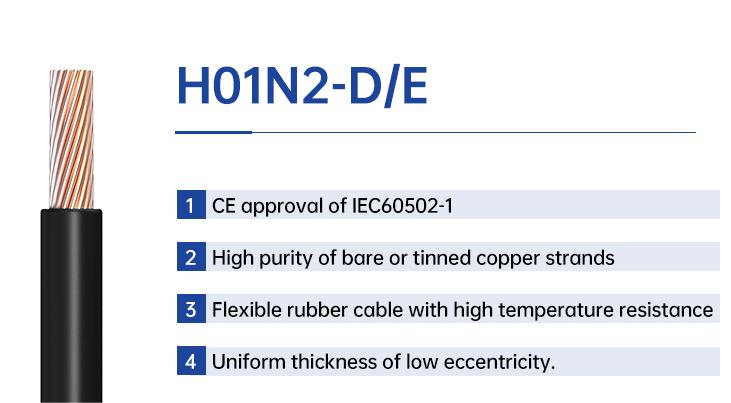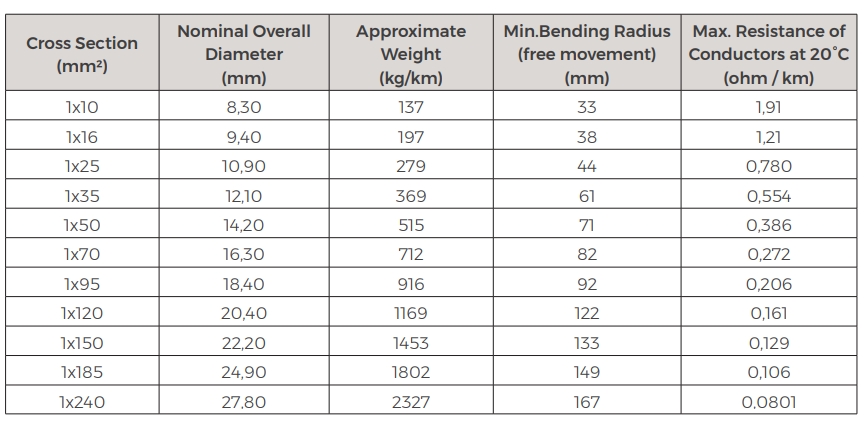Neoprene rubber flex welding cable H01N2-D/H01N2-E are specifically designed for the demanding requirements of welding applications, where durability, flexibility, and resistance to harsh environments are paramount. These welding cable are essential for ensuring safe and effective transmission of high currents needed for welding operations. In this article, we delve into the structure, characteristics, and applications of H01N2-D and H01N2-E cables, and offer a comparative analysis to highlight their differences and specific uses.
Structure of H01N2-D and H01N2-E Cables

H01N2-D Cable:
-
Conductor: The H01N2-D cable features a finely stranded copper conductor, optimizing flexibility and conductivity. The stranding is typically more robust to withstand the mechanical stresses associated with welding equipment.
-
Sheath: The outer sheath of H01N2-D is usually made from a tough rubber material that provides additional protection against abrasion, heat, and other environmental factors.
H01N2-E Cable:
-
Conductor: Similar to H01N2-D, the H01N2-E also uses finely stranded copper for excellent electrical conductivity and flexibility. However, the strands may be slightly finer, enhancing the cable's overall flexibility.
-
Sheath: While also rubberized, the sheath of H01N2-E is designed to be lighter and more flexible than that of H01N2-D, emphasizing ease of use and portability.
Features of H01N2-D and H01N2-E Cables
-
Durability: Both cables are designed to be highly durable, capable of withstanding the rough conditions of welding sites, including exposure to high temperatures, sparks, and abrasive surfaces.
-
Flexibility: While both cables are flexible, H01N2-E is particularly designed for applications requiring frequent movement or repositioning of the welding equipment.
-
Safety: The robust insulation and sheathing materials used in these cables help prevent electrical accidents and ensure that the cables are resistant to flame, heat, and oil.
-
Conductivity: High-quality copper used in both cables ensures excellent conductivity, essential for efficient welding operations.

Applications of H01N2-D and H01N2-E Cables
Both cables are primarily used in the welding industry but are suited for different aspects of welding work:
-
H01N2-D: Ideal for stationary or semi-stationary welding machines where the cable does not need to be moved frequently. It is suitable for harsh industrial environments where mechanical durability is critical.
-
H01N2-E: Best suited for portable welding machines and applications where the cable needs to be frequently moved or repositioned. It is preferred in settings where ease of handling and flexibility are required, such as on construction sites or in workshops.
Comparison Between H01N2-D and H01N2-E Cables
While both H01N2-D and H01N2-E cables serve similar purposes, their differences lie mainly in their flexibility and weight:
-
Flexibility and Weight: H01N2-E cables are lighter and more flexible than H01N2-D cables, making them easier to handle and ideal for portable applications.
-
Durability vs. Maneuverability: H01N2-D cables are more robust and suited for fixed installations or less frequent movement, offering slightly better resistance to physical wear and tear.
Choosing between Neoprene rubber flex welding cable H01N2-D/H01N2-E depends largely on the specific requirements of the welding task, including the type of welding machine used and the work environment. H01N2-D is optimal for demanding industrial applications where cables face severe mechanical stress, while H01N2-E is better for applications requiring greater flexibility and ease of handling. Understanding these cables' unique properties allows welding professionals to make informed choices, ensuring safety, efficiency, and durability in their welding operations. By selecting the right cable, welders can enhance their operational capabilities and maintain compliance with safety standards in the workplace.


